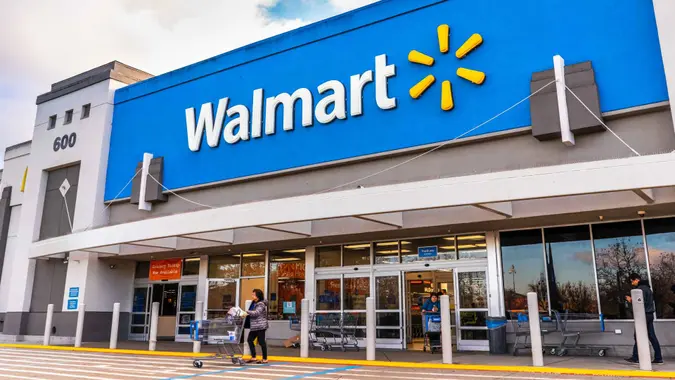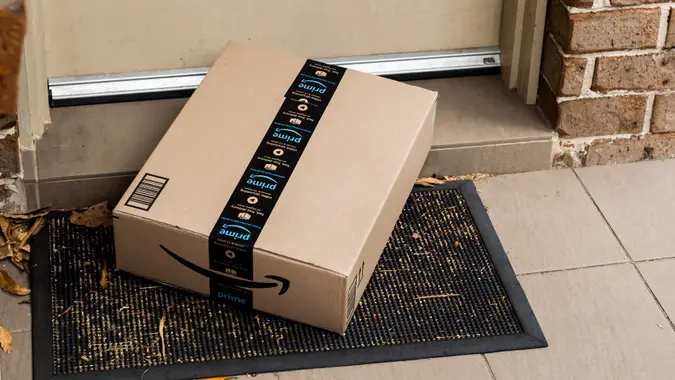Advertiser Disclosure
GOBankingRates works with many financial advertisers to showcase their products and services to our audiences. These brands compensate us to advertise their products in ads across our site. This compensation may impact how and where products appear on this site. We are not a comparison-tool and these offers do not represent all available deposit, investment, loan or credit products.
You Can Save $1,000 a Month by Avoiding These 7 Grocery Store Money Traps
 Written by
Laura Bogart
Written by
Laura Bogart
 Edited by
Gary Dudak
Edited by
Gary Dudak

Commitment to Our Readers
GOBankingRates' editorial team is committed to bringing you unbiased reviews and information. We use data-driven methodologies to evaluate financial products and services - our reviews and ratings are not influenced by advertisers. You can read more about our editorial guidelines and our products and services review methodology.

20 YearsHelping You Live Richer

Reviewed by Experts

Trusted by Millions of Readers
It’s no secret that the price of groceries seems higher than ever. Many of us may not-so-jokingly wonder if we need to take out a loan before browsing the meat aisles.
The Washington Post reports that grocery prices have spiked by 25% over the past four years, causing families and even single shoppers around the country to worry that their cupboards may end up bare. With certain uncontrollable elements such as large-scale weather events or avian flu impacting grocery prices, becoming more resourceful in our shopping habits is a must.
The good news is that with some creativity and flexibility, we can avoid the common issues that turn the checkout lane into a money trap. Here are seven such money traps to avoid when it comes to grocery shopping.
Buying for Just One Meal at a Time
Creating a long-term meal plan can ensure variety for our taste buds, and it can also leave a better taste in our budgets. When you only shop meal-by-meal, you risk buying more ingredients than needed and potentially watching food — and dollars — go to waste. Instead, plan shopping lists that stretch items over multiple meals.One user in a Reddit forum devoted to budget foods shared that they often turn eggs into frittatas that freeze well, combining them with other meats or veggies for a quick and cheap meal. That same user also discussed using shredded carrots with ground meat and spices to pump up the volume of their meatballs, making more food with fewer ingredients.
Looking for Organic in All the Wrong Places
While certain high end grocery stores may have built a brand on high quality organic foods (here’s lookin’ at you, Whole Foods), trekking out to these stores can leave you coming away with a receipt that will make your eyes water (and not your mouth).
The truth is — you don’t need to go to these stores, or even the organic aisles of most big grocery chains, especially if you want to save money.
As GOBankingRates previously reported, becoming a regular at your local farmers’ markets can help you save big on organic produce, provided that you go at the last hour of the day, when many sellers are looking to offload their supply at major discounts.
Leaving Good Discounts on the Table
Most major grocery chains offer daily or weekly flyers chock full of coupons and other discounts. When you walk past these flyers on your way into the store, you often leave these discounts in the dust.
Before creating your grocery list for the week, it’s worth exploring those flyers online or even popping by the store to quickly grab a copy so you can plan your meals around items for sale. Joining loyalty programs is another way to get great deals and other reduced prices.
Not Taking Stock of Your Current Stock
Sometimes, the best place to “grocery shop” is in your own pantry. If you set out for the store without checking to see what you already have, you risk buying duplicate goods that will only go bad because you can’t use them all at once.
Maggie Turansky, founder and head recipe developer at No Frills Kitchen, advises people to start their grocery shopping at home. “Pay attention to what you have that may be expiring in your refrigerator and plan some meals to use up those things instead of buying more,” she explained. “Not only can this save money, but it also minimizes food waste.”
Expecting To Get Everything From One Place
It’s easy to do all your shopping during one trip, at one store. But if you insist on limiting yourself to the store that’s closest, or only shopping at big box chains, you’re hemming yourself into a specific set of prices.
A willingness to make multiple trips to different kinds of stores (within reason) will help you get the best value. For instance, you might find cheaper paper goods or cleaning supplies at a Dollar General while a local market specializing in Indian wares might offer lentils in bulk at a great price.
Hassan Sanders, founder and CEO of Diabetic Insurance Solutions, encourages shoppers to get strategic about where they find what they need. “[Showing] a willingness to diversify shopping venues, from local farmers’ markets and discount stores, to making bulk purchases at warehouse clubs, can … offer quality goods at a fraction of the cost seen in traditional grocery stores,” he said.
Not Buying in Bulk
Choosing not to buy items in bulk is one of the biggest ways to lose out on savings. Simply put, the smaller the item — whether it’s a package of paper towels or frozen chicken — the faster you must replace it. All those replacements beef up your grocery bills, when you should be looking for lean cuts.According to Gabrielle Marie Yap, senior editor and culinary entrepreneur at CarnivoreStyle, buying in bulk is essential for savings. “Bulk buying is my secret weapon when it comes to slashing those grocery expenses,” she said “I kicked things off by grabbing essentials like rice, pasta, and canned goods in larger quantities. Turns out, the price per unit drops significantly when you go big … This trick has been my grocery budget superhero, swooping in to rescue me with an extra 15% in savings.”
Shopping While Hungry
Maybe you think you’ll just be in and out of the store. Maybe you think you’ll just grab a granola bar or a quick snack at the checkout line. But if you go to the grocery store when your belly is rumbling, your wallet is likely to be grumbling because everything looks delicious.
In fact, studies have shown that shoppers who are hungry have spent 64% more money (and not just for food!) than shoppers on a full stomach. So, eat an apple, or two, before you hit the stores. Or, even better, plan to go shopping after you’ve had a full meal.
Share This Article:




You May Also Like



Here's What It Costs To Charge a Tesla Monthly vs. Using Gas for a Toyota Sienna
December 03, 2025
6 min Read


6 Financial Do's and Don'ts for the Holidays, According to Rachel Cruze
December 02, 2025
6 min Read

I'm a Travel Expert: 4 Cheap Destinations Boomers Are Heading To in 2026
December 02, 2025
6 min Read


7 Affordable Holiday Gifts That Will Make Your Grandkids Think You're the Coolest
December 05, 2025
6 min Read



Top 5 Senior-Friendly Cruise Destinations That Are Well Worth the Money
December 04, 2025
6 min Read


5 Most Overpriced Necessities at Amazon That You Should Always Get Elsewhere
December 02, 2025
6 min Read
Best Ways To Save Your Money
Make your money work for you
Get the latest news on investing, money, and more with our free newsletter.
By subscribing, you agree to our Terms of Use and Privacy Policy. Unsubscribe at any time.


Thanks!
You're now subscribed to our newsletter.
Check your inbox for more details.



Sending you timely financial stories that you can bank on.
Sign up for our daily newsletter for the latest financial news and trending topics.
For our full Privacy Policy, click here.
Looks like you're using an adblocker
Please disable your adblocker to enjoy the optimal web experience and access the quality content you appreciate from GOBankingRates.
- AdBlock / uBlock / Brave
- Click the ad blocker extension icon to the right of the address bar
- Disable on this site
- Refresh the page
- Firefox / Edge / DuckDuckGo
- Click on the icon to the left of the address bar
- Disable Tracking Protection
- Refresh the page
- Ghostery
- Click the blue ghost icon to the right of the address bar
- Disable Ad-Blocking, Anti-Tracking, and Never-Consent
- Refresh the page





